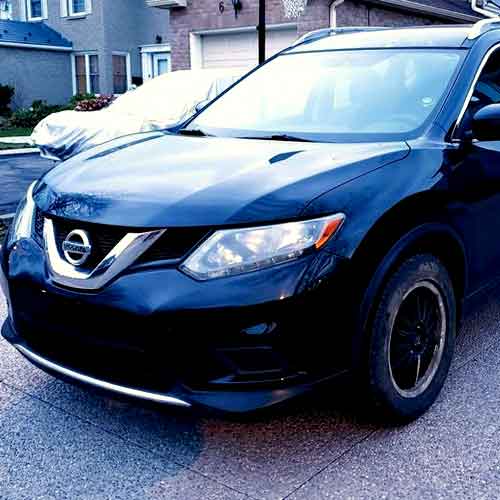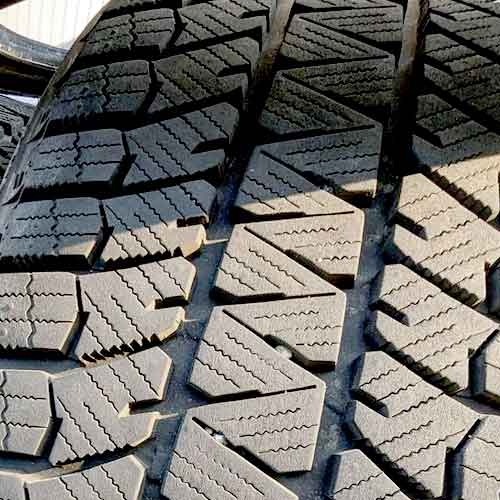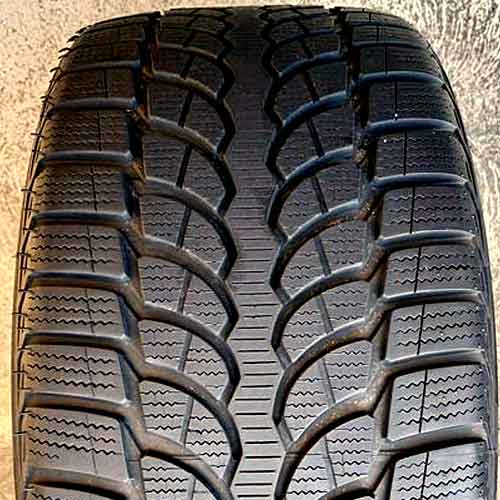Both these winter tires from Bridgestone are noted for their stellar abilities, though they present unique strengths and weaknesses across different parameters such as comfort levels, fuel usage, traction on different surfaces, and dry directional grip.

Table of Contents
Info on Sizes
The Bridgestone Blizzak LM-32 comes in 16 to 20″ with following.
- Speed ratings: H, V and W.
- Load ratings: SL and XL.
- Tread depth: 9 to 12/32″.
- Weight: 22 to 35 lbs.
While the Bridgestone Blizzak WS90 comes in 52 total sizes in 15 to 19 inches (wheels) with following specs.
- Speed ratings: T or H.
- Load ratings: SL or XL.
- Tread depth: 11 or 12/32″.
- Weight: 17 to 29 lbs.
Review this tire in greater detail: https://snowytires.com/bridgestone-blizzak-ws90-review/
Tread Appearance
The Bridgestone Blizzak WS90 is a strong tire for winter, with a special tread design. Let’s break down its key features.

The tread has three main parts, or ribs. So let’s talk about them one by one.
First off, the shoulders, so these lugs are filled with a lot of biters. You get lateral notches facing the middle, and these combined with the longitudinal slits (in the middle of these lugs), yield amazing traction values.
Moreover, these shoulder blocks also have zigzag slits running along near the edges of the tire. And like other winter tires, you get a ton of siping here as well.
The central rib is made continuous, and it features similar slits, which grow wider towards the edges as they meet the V-shaped notches.
These V shaped notches face on both sides laterally.
And of course you get a lot of siping here as well.
On the other hand, Bridgestone Blizzak LM-32 also features a directional pattern.

If we divide up the tread in the same way, we find three parts, or “ribs”, in the middle that look like columns of blocks.
And these make 4 longitudinal channels.
The middle most rib is continuous running, and features rectilinear (lateral) sipes on it.
And yes, with it’s zigzag shape, it makes very tough passing grooves there.
The surrounding ribs have blocks with sharp edges, and interlocking wave-like sipes.
Moreover, you can also see thick slanted slits in them as well.
Moving towards shoulders, you see elongated lugs here, with similar tread features, though you get very prominent longitudinal cuts here (which act as snow sipes).
And yes, these lugs are connected to the following blocks by secondary rubber layers underneath (and those lugs are also connected to the middle-most rib in a similar fashion).
Comfort Levels
When it comes to comfort, the story unfolds in two parts, we have noise reduction department, and then there’s tire’s ability to settle down the road shocks.
Let’s check both out separately.
Road Noise
The primary source of this noise is air particles colliding with the walls of the tread, with the shoulder area serving as the main gateway.
So you can say, the smaller the shoulder voids, the less noise gets produced.
In this respect, the Bridgestone Blizzak WS90 scores more points with its relatively more compact design.
By keeping the shoulder voids small, it restricts the amount of air entering and hitting the tread walls.
However, it doesn’t get to celebrate victory just yet, as the Blizzak LM-32 counters with its pitch sequencing technology.
How this technology works?:
Well it works by putting variations in the tread block geometry, causing the air particles to create different sounds. These various tones then cancel each other out, thereby reducing noise.
So, when it comes to noise, it’s a stalemate between the two tires.
Road Bumps Absorption
Next, let’s talk about the ability to absorb shocks, where the Blizzak WS90 seems to take the lead, with its softer overall tread compound.
The tire’s malleable composition lets it soak up the imperfections of the road in a better way.
Though just like the noise, you get to see yet another plot twist here as well.
You see, the Bridgestone Blizzak LM-32 may seem to be less efficient in soaking up the bumps, it still offers a subjectively better feel of overall steering.
So in the light of these factors, it seems fair to call it a draw between the two when it comes to overall comfort.
Fuel Usage
The fuel efficiency of tires is deeply rooted in the tread design and overall weight, as these elements impact the rolling resistance, a key factor that determines fuel consumption.
And in this regard, both Bridgestone Blizzaks exhibit nearly identical levels of rolling resistance.
The Blizzak WS90, lighter on average across all sizes, has slightly wider tread voids. This results in increased lug movement during maneuvers, which in turn requires additional fuel.
And at the same time, the Bridgestone Blizzak LM-32, despite its heavier weight applying more force on the lugs, manages to strike a balance, with its stiffer compound, leading to equivalent fuel consumption levels.
So, when it comes to fuel efficiency, it’s a draw between these two brothers.
Ice Traction
On icy terrains, the Bridgestone Blizzak WS90 steps into the spotlight with its superior performance.
The tire employs advanced design techniques, like the even distribution of specialized biters across the tread fitted with V-shaped notches.
These notches enable the tire to achieve a better grip on packed terrains. Moreover, the variety of siping angles within its design equips the tire with a multi-directional grip, enhancing traction.
Conversely, the Bridgestone Blizzak LM-32, with a less aggressive siping pattern and lacking multiple angles, finds its overall ice traction somewhat limited.
Fluffy Snow Traction
When it comes to navigating the softer, powdery snow terrains, the Bridgestone Blizzak LM-32 takes a slight lead due to its comprehensive network of tread voids, functioning as snow traps.
These snow traps basically offers superior snow to snow contact, where the lodged snow meeting the ground provides greater friction.
And if you are wondering why that happens, know that naturally, snow like to stick to other snowflakes, instead of rubber.
Simply put, the Bridgestone Blizzak WS90 lacks these specific traits. I mean the tire isn’t able to provide as much snow contact with the lodged snow (in the grooves).
Moreover, with the tire’s smaller tread voids, you also don’t get to see as much paddling where on Blizzak LM-32, snow is thrown backwards and a much better forward momentum is generated.
So overall, Bridgestone Blizzak LM-32 emerges as the superior choice in terms of powdery snow traction.
Dry Directional Grip
The capacity for directional grip is mostly attributed to the central area of the tread, as this region carries the bulk of the tire’s load during straight-line motion, like highway driving.
This specific attribute tells why the Bridgestone Blizzak LM-32 shines in this aspect.
Despite both tires showcasing continuous central ribs for consistent road contact, the Bridgestone Blizzak LM-32’s compact and continuous pattern extending to the surrounding lugs contributes to a shorter braking distance, by approximately 2 feet, compared to the Blizzak WS90.
Thus, the Bridgestone Blizzak LM-32 demonstrates superior linear grip.
Dry Lateral Traction
Handling, or lateral traction performance is largely dependent on the tire’s shoulder structure and overall mass. Allow me to explain why.
During cornering, due to inertia, the weight is displaced to the edges of the tread (shoulders/sidewalls). Though both tires exhibit similar footprints in this area, the heavier Bridgestone Blizzak LM-32 tends to exhibit more lug flex due to its greater weight.
This excessive lug bending leads to an imbalance between understeer and oversteer, compromising the tire’s overall steering feedback.
As a result, the Bridgestone Blizzak WS90 comes out on top in terms of dry handling, providing better control and stability.
Wet Traction
The tire’s traction on wet surfaces hinges greatly on its tread design and the composition of the rubber compound.
And having said that, here, the Bridgestone Blizzak WS90 shines a bit brighter than its rival, even though both tires feature extensive siping.
Sipes in a tire primarily act as channels/voids/slits that expel air and draw in water particles, thereby enhancing wet grip.
And so the Blizzak WS90 leveraging a dual siping system, combining assertive interlocking and linear designs, offers wet traction abilities.
Additionally, the multi-angled sipes present in the Blizzak WS90 offer superior cornering capabilities, ensuring grip in all directions.
On the other hand, the Bridgestone Blizzak LM-32 opts for a different siping approach, featuring predominantly lateral sipes, resulting in a slightly different traction performance.
However, it’s noteworthy that the Bridgestone Blizzak LM-32 excels in resistance to hydroplaning, as the tire demonstrated superior ‘float’ speeds (the maximum speed a tire can maintain over standing water without losing contact with the road) in both straight and curved water-testing scenarios.
To Conclude
Assessing these tires across the spectrum of discussed criteria, it becomes evident that each holds its own appeal based on specific strengths.
The Bridgestone Blizzak WS90 stands out for its commendable performance in wet traction, shock absorption, and ice traction.
On the contrary, the Bridgestone Blizzak LM-32 exhibits superior performance in powdery snow traction and dry directional grip.
It’s also noteworthy that both tires perform equivalently in terms of fuel usage and road noise, making the choice highly dependent on individual requirements and prevalent driving conditions.